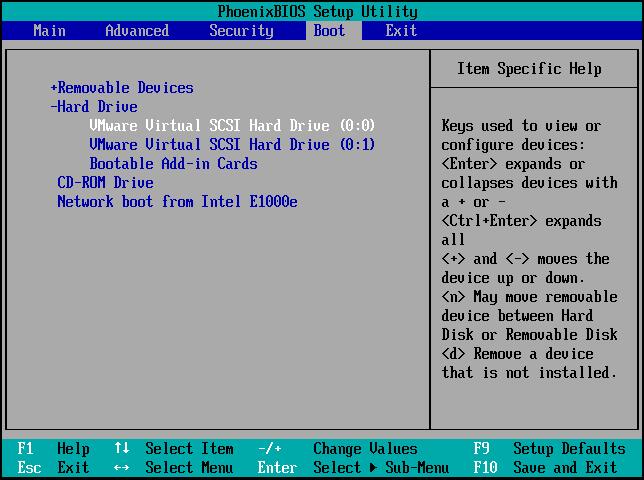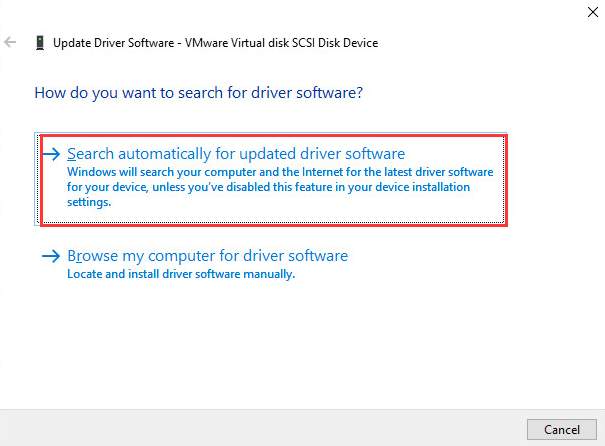Starting with Windows 10, Version 2004 (OS build 19041.488 or higher), two additional identifiers are available for NVMe storage disk drives which support the STOR_RICH_DEVICE_DESCRIPTION structure:
SCSIt*v(8)p(40)
Intel 80332 I/O processor at 500MHz Dual-channel Ultra320 SCSI with support for up to 30 hard drives PCI Express x8 interface Support for up to 512MB of ECC SDRAM Intel RAID Software: Intel RAID BIOS Console, Intel RAID Web Console, and Intel RAID Flash Utilities Microsoft Server Clustering Support. SCSI controllers, RAID controller, PXE enabled network connections, and shadowing of system BIOS all reduce the memory area available to Intel iSCSI Remote Boot. Disable these devices, reboot the system, then see if Intel iSCSI Remote Boot is able to initialize.
Where:
t* is a device type code of variable length
v(8) is an 8-character vendor identifier
p(40) is a 40-character product identifier
SCSIt*v(8)p(40)r(8)
Where:
t* is a device type code of variable length
v(8) is an 8-character vendor identifier
p(40) is a 40-character product identifier
r(8) is an 8-character revision level value
In versions of Windows prior to Windows 10, Version 2004 (OS build 19041.488 or higher), the device ID format for a small computer system interface (SCSI) device is as follows:
SCSIt*v(8)p(16)r(4)
Where:
t* is a device type code of variable length
v(8) is an 8-character vendor identifier
p(16) is a 16-character product identifier
r(4) is a 4-character revision level value
The bus enumerator determines the device type by indexing an internal string table, using a numerically encoded SCSI device type code, obtained by querying the device, as shown in the following table. The remaining components are just strings returned by the device, but with special characters (including space, comma, and any nonprinting graphic) replaced with an underscore.
The SCSI Port driver currently returns the following device type strings, the first nine of which correspond to standard SCSI type codes.
| SCSI type code | Device type | Generic type | Peripheral ID |
|---|---|---|---|
| DIRECT_ACCESS_DEVICE (0) | Disk | GenDisk | DiskPeripheral |
| SEQUENTIAL_ACCESS_DEVICE (1) | Sequential | TapePeripheral | |
| PRINTER_DEVICE (2) | Printer | GenPrinter | PrinterPeripheral |
| PROCESSOR_DEVICE (3) | Processor | OtherPeripheral | |
| WRITE_ONCE_READ_MULTIPLE_DEVICE (4) | Worm | GenWorm | WormPeripheral |
| READ_ONLY_DIRECT_ACCESS_DEVICE (5) | CdRom | GenCdRom | CdRomPeripheral |
| SCANNER_DEVICE (6) | Scanner | GenScanner | ScannerPeripheral |
| OPTICAL_DEVICE (7) | Optical | GenOptical | OpticalDiskPeripheral |
| MEDIUM_CHANGER (8) | Changer | ScsiChanger | MediumChangerPeripheral |
| COMMUNICATION_DEVICE (9) | Net | ScsiNet | CommunicationsPeripheral |
| 10 | ASCIT8 | ScsiASCIT8 | ASCPrePressGraphicsPeripheral |
| 11 | ASCIT8 | ScsiASCIT8 | ASCPrePressGraphicsPeripheral |
| 12 | Array | ScsiArray | ArrayPeripheral |
| 13 | Enclosure | ScsiEnclosure | EnclosurePeripheral |
| 14 | RBC | ScsiRBC | RBCPeripheral |
| 15 | CardReader | ScsiCardReader | CardReaderPeripheral |
| 16 | Bridge | ScsiBridge | BridgePeripheral |
| 17 | Other | ScsiOther | OtherPeripheral |
An example of a device ID for a disk drive would be as follows:
SCSIDiskSEAGATE_ST39102LW_______0004
There are four hardware IDs in addition to the device ID:
SCSIt*v(8)p(16)
SCSIt*v(8)
SCSIv(8)p(16)r(1)
V(8)p(16)r(1)
In the third and fourth of these additional identifiers, r(1) represents just the first character of the revision identifier. These hardware IDs are illustrated by the following examples:
SCSIDiskSEAGATE_ST39102LW_______
SCSIDiskSEAGATE_
SCSIDiskSEAGATE_ST39102LW_______0
SEAGATE_ST39102LW_______0

Intel Scsi & Raid Devices Driver Download For Windows 8.1
The SCSI Port driver supplies only one compatible ID, one of the variable-sized generic type codes from the previous table.
For example, the compatible ID for a disk drive is as follows:
Intel Scsi & Raid Devices Driver Download For Windows 7
GenDisk
The generic identifier is used in INF files for SCSI devices more than any other, because SCSI drivers are typically generic.
Be aware that the SCSI Port driver returns no generic name for sequential access and 'processor' devices.
Short for Small Computer System Interface, SCSI is pronounced as 'Scuzzy' and is an interface for disk drives that was first completed in 1982. Unlike competing standards, SCSI is capable of supporting eight devices, or sixteen devices with Wide SCSI. However, with the SCSI host adapter on ID number 07 and booting from the ID 00. This leaves the availability of six device connections. In the picture below, is an example of a SCSI adapter expansion card with an internal and external connection. Once installed in the computer, this adapter would allow multiple SCSI devices to be installed in the computer. More advanced motherboard may also have available SCSI connections on the motherboard.


SCSI-1 is the original SCSI standard developed back in 1986 as ANSI X3.131-1986. SCSI-1 is capable of transferring up to eight bits a second.

SCSI-2 was approved in 1990, added new features such as Fast and Wide SCSI, and support for additional devices.
SCSI-3 was approved in 1996 as ANSI X3.270-1996.
SCSI is a standard for parallel interfaces that transfers information at a rate of eight bits per second and faster, which is faster than the average parallel interface. SCSI-2 and above supports up to seven peripheral devices, such as a hard drive, CD-ROM, and scanner. They can all attach to a single SCSI port on a system's bus. SCSI ports were designed for Apple Macintosh and Unix computers, but also can be used with PCs. Although SCSI was popular in the past, today it has largely been superseded by faster connection types, such as SATA.
Intel SCSI & RAID Devices Driver Download For Windows
SCSI connectors
Intel Scsi & Raid Devices Driver Download For Windows 10
The illustrations below are examples of commonly-used SCSI connectors on computers and devices.
Related pages
Intel Scsi & Raid Devices Driver Download For Windows Xp
Cable, Computer acronyms, Connection, Data cable, Fast Wide SCSI, Hard drive terms, Initiator, iSCSI, Phases, SAS, SCSI bus, SCSI cable, SCSI chain, SCSI device, SCSI-to-SCSI cable, Terminate, Ultra SCSI
